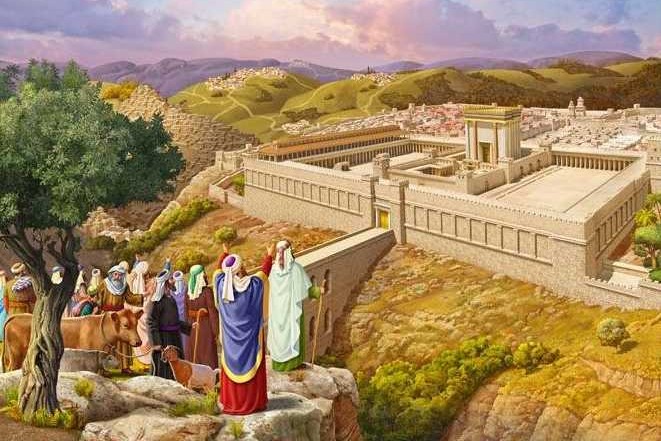“And you shall declare on that very day, that it is a Holy Day unto you; You shall do no manner of work; It is an Eternal Statute, in all your habitations, for all your generations” (Vayikra 23:21)
“Until the day after the seventh week, you shall count, fifty days; And you shall bring a ‘New’ Grain Offering to Hashem” (Vayikra 23:16)
“And it was on the third day, as it became morning, and there was thunder and lightning, and a thick cloud on the mountain, and the sound of the Shofar was very strong, and all the people in the camp were seized with trembling” (Shemot 19:16)
One of the Three “Regalim”
 Along with Pesach (Passover) and Sukkot, Shavuot is one of the Three “Pilgrimage Festivals” on which Jewish families, especially the males, who are freer to leave at specific times, such as the times of these holidays, and are not charged as much with the responsibilities of the home and the raising of children, are commanded to appear at the Temple in Jerusalem.
Along with Pesach (Passover) and Sukkot, Shavuot is one of the Three “Pilgrimage Festivals” on which Jewish families, especially the males, who are freer to leave at specific times, such as the times of these holidays, and are not charged as much with the responsibilities of the home and the raising of children, are commanded to appear at the Temple in Jerusalem.
The root of the word “Regalim” is “regel,” which means “foot.” “Pilgrim” means one who travels; on each of these festivals, the family is expected to make the effort to travel to Yerushalayim.
Concerning these holidays it is written (Shemot 23, 14-19):
“Three Regalim celebrate before Me each year. Observe the Holiday of the Matzot, Passover; Seven days shall you eat Matzot as I have commanded you, in the month of the Spring, for it was at that time that you left Egypt, and My Presence shall not be seen by you empty-handed.”
“And the Holiday of Bringing in your First Fruits (Shavuot) which you had planted in the field,”
“and the Harvest Festival Sukkot, at the turn of the year, when you gather your produce from the field.”
“Three times each year shall each of your males be seen by the Master, Hashem…The first fruits of the land you shall bring to the House of the L-rd your G-d…”
Climax of the Sefirat HaOmer
In Vayikra (23,15) the People of Israel is commanded to count seven complete weeks, beginning with the second day of Pesach, or Passover, for a total of forty-nine days. This counting is called Sefirat HaOmer because the Omer Offering is brought on the Second Day of Pesach. The last day of the count, the forty-ninth day, is Erev Shavuot. The day after the full count of forty-nine is complete, the “fiftieth day,” is Shavuot. That day is a holiday unto itself, with its own unique character, and ritual.
We read in Vayikra (23,16) “Until the day after the seventh week you shall count, fifty days; and you shall offer a new meal-offering to Hashem.” The meal-offering of Shavuot is called “new” because it was the first Temple offering from the new wheat crop (the Omer-offering of Pesach was of barley).
In the realm of years, there is a similar count. Each seven years is called a Shemitah cycle, with each seventh year called a Shemitah, or Sabbatical, Year. Seven such cycles make up a count of forty-nine years. The year following the count, Year number fifty, is called the Yovel, or Jubilee, Year.
The English name of the Shemittah Year, Sabbatical Year, suggests or, rather, confirms that a major unit of time in Judaism is the number seven, as we see in Shabbat, the Seventh Day, of each week.
“Zeman Matan Torateinu,” Time of the Giving of the Torah:
The Torah is the life of the Jew. Without the Torah, life would be meaningless, not only for the Jewish People, but for the whole world as well. For it can be said, from the religious perspective, and that is our perspective, that the rest of Nature exists only for the human race, G-d’s most beloved creatures. And the human race has no purpose other than to learn from the Jewish People, who will ultimately fulfill their destiny of being “a light unto the Nations.” And the light spoken of is none other than the light of Torah, Hashem’s Book, which is the “Proper Study of Man.”
Therefore, it is obvious that the event of G-d’s giving His holy treasure to the Jewish People was a somewhat important date (!) And yet, the Torah itself does not specify the exact date on which the Master of the Universe revealed Himself, so to speak, at Mt. Sinai, and transmitted His Law to the Jewish People and, through them, to the world at large.
The Talmud debates whether it was the sixth or the seventh of Sivan, and the decision is actually in favor of the opinion that it was given on the seventh. Nevertheless, for various reasons, we celebrate it on the sixth of Sivan [which will be assumed in “The Story of Shavuot”] in Israel, and we begin its celebration on the sixth in the Diaspora as well, continuing it into the seventh.
The Midrash records that Moshe debated with the Angels whether Man was worthy of receiving the great gift of the Torah. Fortunately for all of us, Moshe was judged the winner of that debate.

